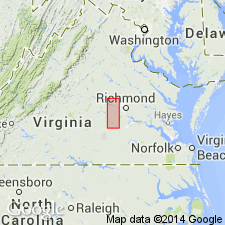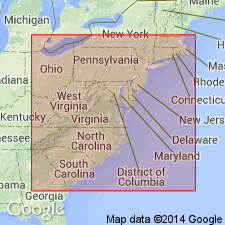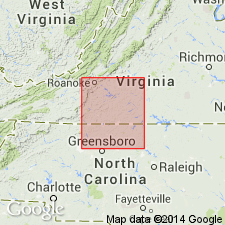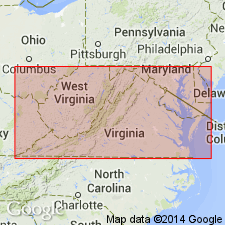
- Usage in publication:
-
- Tuckahoe group*
- Modifications:
-
- Named
- Dominant lithology:
-
- Coal
- AAPG geologic province:
-
- Piedmont-Blue Ridge province
Summary:
The lower rocks of the Newark series in the Richmond basin are named the Tuckahoe Group. It contains the informal Boscabel bowlder [sic] beds, the lower barren beds, and the productive coal measures, which consist of 3 to 5 seams of bituminous coal interbedded with sandstone and fossiliferous black shale. The coal has been converted to coke where dikes have intruded the coal seams. The upper coal seam is the thickest, varying from 30-40 ft (9-12 m) thick near Midlothian. Thickness of entire coal measures is about 500 ft (150 m). Age is Late Triassic.
Source: GNU records (USGS DDS-6; Reston GNULEX).

- Usage in publication:
-
- Tuckahoe Group
- Modifications:
-
- Biostratigraphic dating
- AAPG geologic province:
-
- Piedmont-Blue Ridge province
Summary:
The age of the Chatham-Richmond-Taylorsville palynoflora is probably late middle to early late Carnian, but may be entirely late middle Carnian.
Source: GNU records (USGS DDS-6; Reston GNULEX).

- Usage in publication:
-
- Tuckahoe Group*
- Modifications:
-
- Areal extent
- Revised
- AAPG geologic province:
-
- Piedmont-Blue Ridge province
- Deep Run basin
- Richmond basin
Summary:
The basal part of the Tuckahoe Group, here called simply coal measures, is mapped in the Richmond basin and in 5 small outliers on the northeastern side. [These include the Deep Run basin and an outlier along Flat Branch].
Source: GNU records (USGS DDS-6; Reston GNULEX).

- Usage in publication:
-
- Tuckahoe Formation
- Modifications:
-
- Revised
- AAPG geologic province:
-
- Piedmont-Blue Ridge province
- Richmond basin
Summary:
Nomenclature in this report follows Ediger and others (in prep). Richmond basin sequence is divided into three formations (ascending): Tuckahoe, Turkey Branch, and Otterdale Formations of Newark Supergroup. Contacts are unconformable. Tuckahoe Formation is divided into (ascending) Lower Barren Beds Member, Productive Coal Measures Member, and Vinita Beds Member. Lower Barren Beds Member deposited in fluvial, overbank, and floodplain-restricted lacustrine environments. Only the top of this member crops out in limited areas. Similar to basal fluvial sediments of the Taylorsville basin. The lower Productive Coal Measures Member is dominated by sandstones and coal and the upper part by shales and siltstones. This member does not have an equivalent in the Taylorsville basin. Lower part of the Vinita Beds Member is dominantly lacustrine. Higher in the member, sediments become deltaic-fluvial in origin. The Vinita correlates with the lower part of the Falling Creek Member of the Doswell Formation in the Taylorsville basin. Age of the Tuckahoe is early to middle Carnian. . [Member names as used in this report are in violation of the NACSN and though presented as formal, should be considered informal.]
Source: GNU records (USGS DDS-6; Reston GNULEX).
For more information, please contact Nancy Stamm, Geologic Names Committee Secretary.
Asterisk (*) indicates published by U.S. Geological Survey authors.
"No current usage" (†) implies that a name has been abandoned or has fallen into disuse. Former usage and, if known, replacement name given in parentheses ( ).
Slash (/) indicates name conflicts with nomenclatural guidelines (CSN, 1933; ACSN, 1961, 1970; NACSN, 1983, 2005, 2021). May be explained within brackets ([ ]).

